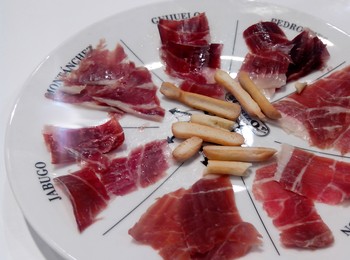 If you are asked which is saltier, a slice of Iberian jamón de bellota or a crisp? The answer will almost always be the crisp. Moreover, if I ask you to first try a sample of each, the answer wouldn’t change.
If you are asked which is saltier, a slice of Iberian jamón de bellota or a crisp? The answer will almost always be the crisp. Moreover, if I ask you to first try a sample of each, the answer wouldn’t change.
The reality is very different: a bag of crisps typically contains 1.5g of salt per 100g of potatoes, while Pata Negra ham contains between 3 to 4.5g per 100g. Even the Serrano ham, which usually doesn’t even reach 5% salt content, seems significantly saltier than Bellota ham despite it having only slightly more salt.
Another example: seawater has a salinity of about 3.5%, but it seems much saltier than jamón.
What masks the salt?
The marbling fat and protein deserve credit in this case. As everyone knows, Iberian ham has a lot of fat marbling, which means the white streaks in the slice. If it’s also Bellota, the fat will melt in the mouth and inundate our taste buds. Thus, our taste buds will be concentrated on the fat and stop being so sensitive to the salt (the sodium of the salt, to be exact).
On the other hand, during the 3 or 4-year maturation period of a good Pata Negra, the salt combines with meat protein, reducing its impact on the taste buds.
Whereas Jamón de bellota seems sweet, it actually doesn’t have much less salt than Serrano ham. You should always follow the recommendations of experts not to consume cured ham more than 2 or 3 times a week, the equivalent to between 100 and 150g, and thus will not reach 15% of the recommended daily allowance (RDA) by WHO (World Health Organisation). We can raise this amount if we moderate our consumption of salt in other foods such as salads and soups, for example. Worth the sacrifice, right?
